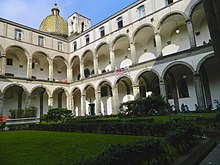Ancient higher-learning institutions
[6][4] In Fez, Fatima al-Fihri established a madraza in 859 CE, which eventually became the organization of higher learning, the currently named University of al-Qarawiyyin.
[6][4] In the fourth century CE, amid the reign of Emperor Ella Amida, the Axumite imperial church served as an organization of higher learning.
[3][4] Major Buddhist monasteries (mahaviharas), notably those at Pushpagiri, Nalanda, Valabhi, and Taxila, included schools that were some of the primary institutions of higher learning in ancient India.
The Chinese traveller Xuanzang (Hiuen Tsang), who visited it in 639 CE, as Puphagiri Mahavihara,[13][14] as well as in medieval Tibetan texts.
However, unlike Takshila and Nalanda, the ruins of Pushpagiri were not discovered until 1995, when a lecturer from a local college first stumbled upon the site.
[15][16] The task of excavating Pushpagiri's ruins, stretching over 58 hectares (143 acres) of land, was undertaken by the Odisha Institute of Maritime and South East Asian Studies between 1996 and 2006.
[21] The school consisted of several monasteries without large dormitories or lecture halls where the religious instruction was most likely still provided on an individualistic basis.
Seowons were private institutions established during the Joseon dynasty which combined functions of a Confucian shrine and a preparatory school.
The Seonggyungwan was founded by in 1398 to offer prayers and memorials to Confucius and his disciples, and to promote the study of the Confucian canon.
It was an important medical centre of the sixth and seventh centuries and a prominent example of higher education model in pre-Islam Persia.
[34] Some 400 years later, during the fourth century CE, the Platonist philosopher Plutarch of Athens started a school which identified itself with Plato's Academy that lasted until 529, when it was closed following an edict from the Emperor Justinian prohibiting pagans from teaching.
[35] Around 335 BCE, Plato's successor Aristotle founded the Peripatetic school, the students of which met at the Lyceum gymnasium in Athens.
[36] The University of Constantinople, founded as an institution of higher learning in 425, educated graduates to take on posts of authority in the imperial service or within the Church.
[39] It was reorganized as a corporation of students in 849 by the regent Bardas of emperor Michael III, is considered by some to be the earliest institution of higher learning with some of the characteristics we associate today with a university (research and teaching, auto-administration, academic independence, et cetera).
If a university is defined as "an institution of higher learning" then it is preceded by several others, including the Academy that it was founded to compete with and eventually replaced.
[40] These early episcopal schools, with a focus on an apprenticeship in religious learning under a scholarly bishop, have been identified in Spain and in about twenty towns in Gaul during the sixth and seventh centuries.





